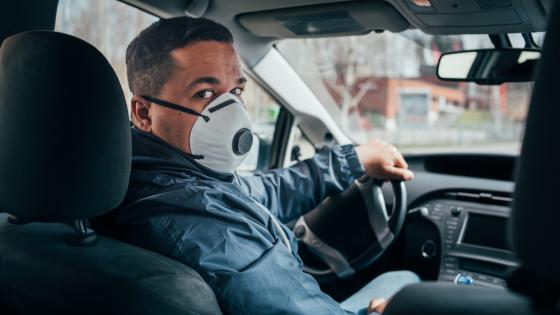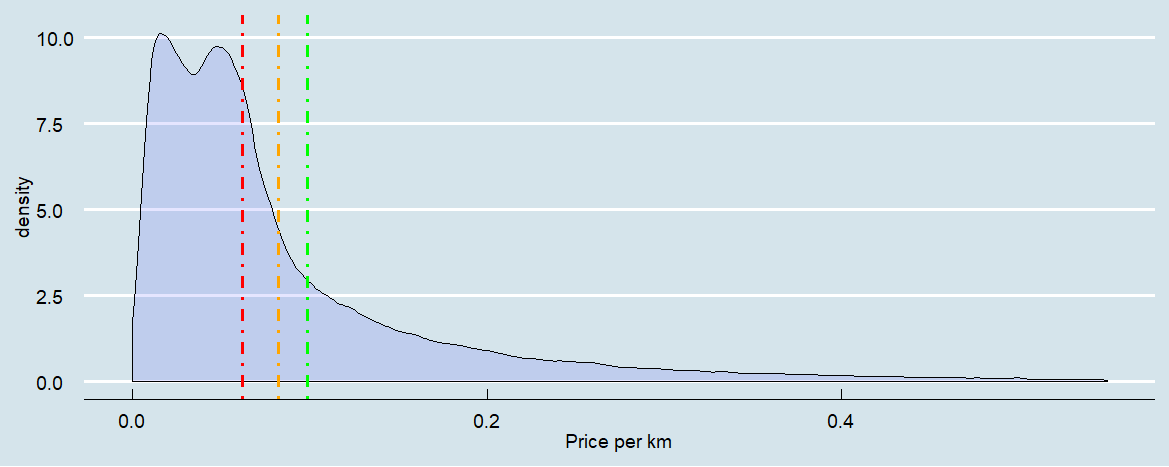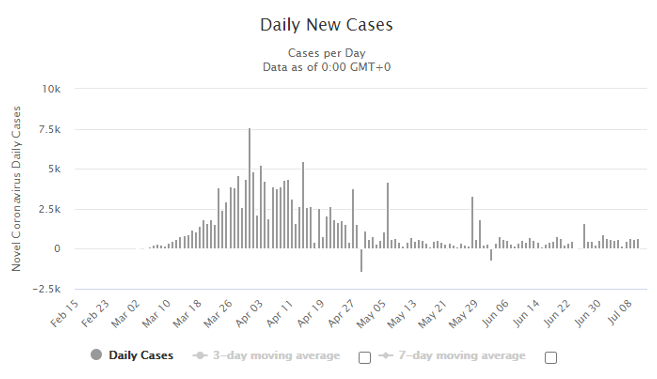The pandemic notwithstanding, equitable and cost-effective transportation systems are indispensable to the functioning of modern economies. In recent months, public health experts have repeatedly called on consumers to avoid crowded and enclosed spaces, both of which are typically associated with ridesharing. The impact of the health hazard on access to, and prices of, such services is a crucial input for devising policies that can ensure the fair and efficient functioning of ridesharing markets in the time of Covid-19.
Socio-demographics have impacted behaviour during the pandemic (Papageorge et al. 2020). Individuals at the lower end of the income distribution adapted their behaviour to a lesser extent, due in part to a lower potential for teleworking opportunities (Milasi et al. 2020).
Minorities (ethnic and racial) are a particularly vulnerable group. They might find it harder to adapt their behaviour due to their employment profiles, and are likely to face discrimination on online platforms (e.g. Edelman and Luca 2014). Furthermore, the risk of infection has long been argued to aggravate discriminatory behaviour (e.g. Shaller and Neuberg 2012, Jedwab et al. 2020). Covid-19 is no different; recent research showed magnified hostility towards foreigners (Bartos et al. 2020) and a particularly severe effect on the animosity towards Asians (Lu and Sheng 2020).
Risk and uncertainty are considered major factors in shaping the behaviour of consumers and businesses as countries emerge from Covid-19-induced lockdowns. In the first CEPR Press eBook on the economics of Covid-19 (Baldwin and Weder di Mauro (2020), the word “uncertainty” appears 32 times. Optimal policy design must consider how such risks and uncertainties impact prices and access to transportation. In our recent paper (Ivaldi and Palikot 2020), we explore timely data on ridesharing usage, pricing, and access, shedding light on the impact of Covid-19 impact on this market.
Context and data
Our analysis focuses on the rides posted on a platform called BlaBlaCar, the global leader of city-to-city ridesharing. BlaBlaCar was established in France, where it remains very popular. Drivers are mostly non-professionals looking for a way to cover the costs of day-to-day commutes or longer trips. On BlaBlaCar, drivers set the price while passengers observe available drivers and send booking requests. Some drivers use automatic acceptance; others reserve the option to manually review booking requests.
Our sample starts on 8 May 2020, when France was in lockdown, and continues until 12 July, which is after the mobility restrictions were lifted. We study trips departing from each of the regional capitals of mainland France. Thus, we observe the impact of the Covid-19 outbreak both in time and across regions.
High and dispersed prices
BlaBlaCar drivers receive price recommendations but frequently deviate from them. Figure 1 shows the distribution of prices per km in our sample.
Figure 1 Price recommended by BlaBlaCar (red line), mean price in Lambin and Palikot (2019) (orange line), and mean in the Covid-19 sample (green line)
The long tail of high prices and a mass of very cheap rides are immediate observations from Figure 1. We use two reference points: the recommended price and the mean price per kilometre in Lambin and Palikot (2019), based on a sample of comparable rides in 2018 and 2019. The long tail of very high prices pushes the mean substantially above the two reference points. The distribution presented in Figure 1 exhibits a high degree of dispersion; the coefficient of variation (the ratio of the standard deviation to mean) is significantly higher than in Lambin and Palikot (2019) (1.11 versus 0.83).
Regions severely impacted by the Covid-19 have few trips and high prices
Figure 2 shows the geographical variation in the number of deaths per 100,000 inhabitants per department.1 Drivers departing from cities in departments heavily hit by the Covid-19 outbreak might consider the increased health risk involved in welcoming a stranger into their car.
Figure 2 Logarithm of the number of deaths per thousand inhabitants per department
Source: https://www.data.gouv.fr/
We confirm this intuition using regression analysis: we find that fewer trips are departing from departments impacted heavily by Covid-19 (measured by the number of positive cases, hospitalisations, and deaths) and that these trips are substantially more expensive. An increase in the number of positive cases per thousand by one unit is associated with a price spike of 6.5%.
Ridesharing might be more expensive in the departments severely impacted by Covid-19 for at least two reasons: availability of public transportation and health risks included in the price. We disentangle the two effects and show that drivers do indeed consider health hazards by exploring shocks (positive and negative) to the number of reported daily cases of new Covid-19 infections (see Figure 3).
Figure 3 Daily reports of Covid-19 cases in France
Source: https://www.worldometers.info/coronavirus/country/france/
Such day-to-day jumps might be due to mistakes in earlier reporting, or to a large batch of tests carried out on a given day. Such shocks might impact drivers’ perceptions of the health hazard. We find that prices after (before) the positive (negative) shock are lower (higher) than during it. This result reinforces our conclusion that health-hazards play a role in shaping the prices of ridesharing.
More across-ethnicity mixing but signs of discrimination
Sheltering at home to avoid the risk of infection is not a luxury available to all. Underprivileged groups are less likely to remain at home, increasing their numbers among the share of users on a ridesharing platform (Papageorge et al. 2020). On the other hand, previous research (O'Shea et al. 2020) shows that exposure to infectious diseases exacerbates racial prejudice. Thus, use of the platform by ethnic or racial minorities during the pandemic is an open question.
For drivers in our dataset, we see all their reviews, together with the name and photo of the reviewer. We use these names to determine the gender and ethnicity of reviewers. Specifically, we are interested in detecting whether the driver and the passenger (who left the review) belong to an ethnic minority (in this case, African or Arabic).
We find that the dominant effect of the pandemic on the ethnic composition of users is to increase the number of passengers from ethnic minorities: a non-minority driver before the pandemic had on average 8% minority passengers before and 13% during the pandemic, while minority drivers increased their share of minority passengers from 16% to 23%.
Using a panel data set in which we study within-driver variation in the probability that a passenger is from a minority (thus controlling for driver fixed effects), we find that non-minority drivers are more likely to travel with a minority passenger. However, we also find that drivers who use manual mode to review a booking request are less likely to accept a minority passenger during the pandemic than before it.
Conclusion
Because our work relies on observational data, our results should not be seen as causal evidence. Furthermore, the results are, in large part, unsurprising. Prior research has documented instances of racial and ethnic discrimination on online platforms, and the risk of infection has long been associated with increased discriminatory behaviour (Shaller and Neuberg 2012). Furthermore, a long tradition in economics has argued that individuals price health-related risks.
Nevertheless, we show that these effects have a substantial economic impact. Hence, governments, like that of France, that encourage the use of ridesharing during the Covid-19 pandemic should take steps to guarantee equality of access, and work together with private-sector partners to ensure the efficient functioning of such services.
References
Baldwin, R and B Weder di Mauro (2020), Economics in the Time of COVID-19, CEPR Press.
Edelman, B G and M Luca (2014), “Digital discrimination: The case of Airbnb.com.”, Harvard Business School NOM Unit Working Paper, 14–054.
Ivaldi, M and E Palikot (2020), “Sharing when stranger equals danger: Ridesharing during Covid-19 pandemic”, Covid Economics 46.
Jedwab, R, N Johnson and M Koyama (2020), “Pandemics and the persecution of minorities: Evidence from Black Death”, VoxEU.org, 3 May.
Lambin, X and E Palikot (2019), “The Impact of Online Reputation on Ethnic Discrimination”, TSE Mimeo.
Lu, R and Y Sheng (2020), “From Fear to Hate: How the Covid-19 Pandemic Sparks Racial Animus in the United States”, Available at SSRN 3646880.
O’Shea, B A, D G Watson, G D Brown and C L Fincher (2020), “Infectious disease prevalence, not race exposure, predicts both implicit and explicit racial prejudice across the United States”, Social Psychological and Personality Science 11(3): 345–355.
Papageorge, N W, M V Zahn, M Belot, E van den Broek-Altenburg, S Choi, J C Jamison and E Tripodi (2020), “Socio-Demographics predict behaviour during a pandemic”, VoxEU.org, 5 September.
Schaller, M and S L Neuberg (2012), “Danger, disease, and the nature of prejudice(s)”, Advances in Experimental Social Psychology 46: 1–54.
Milasi, S, M Bisello, J Hurley, M Sostero and E Fernandez-Macias (2020), “The potential for teleworking in Europe and the risk of a new digital divide”, VoxEU.org, 14 August.
Endnotes
1 Departments (from French “département”) are the administrative unit of France; they are the middle of three levels of the regional government, between the regions and the communes.






